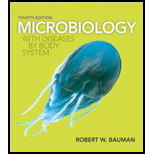
Microbiology with Diseases by Body System (4th Edition)
4th Edition
ISBN: 9780321918550
Author: Robert W. Bauman Ph.D.
Publisher: PEARSON
expand_more
expand_more
format_list_bulleted
Concept explainers
Question
Chapter 25, Problem 13CT
Summary Introduction
To answer:
The process that would yield more product from the same sized vats over the same amount of time: batch production or continuous flow production and why.
Introduction:
Batch culture is also called as a closed culture in which limited substrate is added to the growth of organism inside the fermenter. While continuous culture is also called as an open culture, in which substrates are continuously supplied for the growth of microorganisms.
Expert Solution & Answer
Want to see the full answer?
Check out a sample textbook solution
Students have asked these similar questions
A 25-year-old woman presents to the emergency department with a 2-day history of fever, chills, severe headache, and confusion. She recently returned from a trip to sub-Saharan Africa, where she did not take malaria prophylaxis. On examination, she is febrile (39.8°C/103.6°F) and hypotensive. Laboratory studies reveal hemoglobin of 8.0 g/dL, platelet count of 50,000/μL, and evidence of hemoglobinuria. A peripheral blood smear shows ring forms and banana-shaped gametocytes. Which of the following Plasmodium species is most likely responsible for her severe symptoms?
A.
Plasmodium vivax
B.
Plasmodium ovale
C.
Plasmodium malariae
D.
Plasmodium falciparum
Standard Concentration (caffeine) mg/L
Absorbance Reading
10
0.322
20
0.697
40
1.535
60
2.520
80
3.100
Please draw in the missing answer, thank you
Chapter 25 Solutions
Microbiology with Diseases by Body System (4th Edition)
Ch. 25 - Prob. 1TMWCh. 25 - Prob. 2TMWCh. 25 - Prob. 1MCCh. 25 - Prob. 2MCCh. 25 - Prob. 3MCCh. 25 - Prob. 4MCCh. 25 - Prob. 5MCCh. 25 - Strains of the bacterium Pseudomonas syringae have...Ch. 25 - Prob. 7MCCh. 25 - Prob. 8MC
Ch. 25 - Prob. 9MCCh. 25 - Prob. 19MCCh. 25 - Lyophilization in food preservation is by...Ch. 25 - Prob. 1MTFCh. 25 - Prob. 2MTFCh. 25 - Prob. 3MTFCh. 25 - Prob. 4MTFCh. 25 - Prob. 5MTFCh. 25 - Intrinsic factors affecting food spoilage are...Ch. 25 - Prob. 2FIBCh. 25 - Prob. 3FIBCh. 25 - Potable water is allowed to have ________...Ch. 25 - A ________ is a device composed of microbes and...Ch. 25 - Prob. 10FIBCh. 25 - Prob. 1MCh. 25 - Why does the application or recombinant DNA...Ch. 25 - Given what you know about microbial nutrition and...Ch. 25 - Prob. 3CTCh. 25 - Prob. 4CTCh. 25 - Even though water and wastewater undergo...Ch. 25 - Take a critical look at the garbage in all of your...Ch. 25 - Prob. 7CTCh. 25 - Explain why sakesometimes called rice winewould be...Ch. 25 - Prob. 10CTCh. 25 - Prob. 11CTCh. 25 - Suggest why neither the original food involved nor...Ch. 25 - Prob. 13CTCh. 25 - Prob. 14CTCh. 25 - Prob. 1CMCh. 25 - A blogger stated that germs (microorganisms) are...Ch. 25 - Compare human, animal, and plant pathogens that...Ch. 25 - A microbiome is composed of _____. a. single, pure...Ch. 25 - In the environment, nutrients are generally _____....Ch. 25 - Prob. 12MCCh. 25 - Prob. 13MCCh. 25 - Nitrification converts _____. a. organic nitrogen...Ch. 25 - Prob. 15MCCh. 25 - Which of the following diseases is not caused by...Ch. 25 - Of the following characteristics, which would...Ch. 25 - Anammox reactions are ____. a. anaerobic and pan...Ch. 25 - Prob. 6MTFCh. 25 - Modified True/False 1. _____ Biofilms of...Ch. 25 - Prob. 8MTFCh. 25 - Modified True/False 3. __________ Aquatic...Ch. 25 - Prob. 10MTFCh. 25 - Fill in the Blanks 1. Leaching of compounds from...Ch. 25 - Prob. 6FIBCh. 25 - Prob. 7FIBCh. 25 - Prob. 8FIBCh. 25 - Prob. 1VICh. 25 - Prob. 2VICh. 25 - Prob. 8CTCh. 25 - Microbes are found mostly in topsoil, but some are...
Knowledge Booster
Learn more about
Need a deep-dive on the concept behind this application? Look no further. Learn more about this topic, biology and related others by exploring similar questions and additional content below.Similar questions
- a. On this first grid, assume that the DNA and RNA templates are read left to right. DNA DNA mRNA codon tRNA anticodon polypeptide _strand strand C с A T G A U G C A TRP b. Now do this AGAIN assuming that the DNA and RNA templates are read right to left. DNA DNA strand strand C mRNA codon tRNA anticodon polypeptide 0 A T G A U G с A TRParrow_forwardplease answer all question below with the following answer choice, thank you!arrow_forwardplease draw in the answeres, thank youarrow_forward
- A) What is being shown here?B) What is indicated by the RED arrow?C) What is indicated by the BLUE arrow?arrow_forwardPlease identify the curve shown below. What does this curve represent? Please identify A, B, C, D, and E (the orange oval). What is occurring in these regions?arrow_forwardPlease identify the test shown here. 1) What is the test? 2) What does the test indicate? How is it performed? What is CX? 3) Why might the test be performed in a clinical setting? GEN CZ CX CPZ PTZ CACarrow_forward
- Determine how much ATP would a cell produce when using fermentation of a 50 mM glucose solution?arrow_forwardDetermine how much ATP would a cell produce when using aerobic respiration of a 7 mM glucose solution?arrow_forwardDetermine how much ATP would a cell produce when using aerobic respiration to degrade one small protein molecule into 12 molecules of malic acid, how many ATP would that cell make? Malic acid is an intermediate in the Krebs cycle. Assume there is no other carbon source and no acetyl-CoA.arrow_forward
arrow_back_ios
SEE MORE QUESTIONS
arrow_forward_ios
Recommended textbooks for you
- Basic Clinical Lab Competencies for Respiratory C...NursingISBN:9781285244662Author:WhitePublisher:Cengage

Basic Clinical Lab Competencies for Respiratory C...
Nursing
ISBN:9781285244662
Author:White
Publisher:Cengage





6th Grade Science - Module 2: Physical & Chemical Properties; Author: iUniversity Prep;https://www.youtube.com/watch?v=4DONkU6c2Rs;License: Standard youtube license